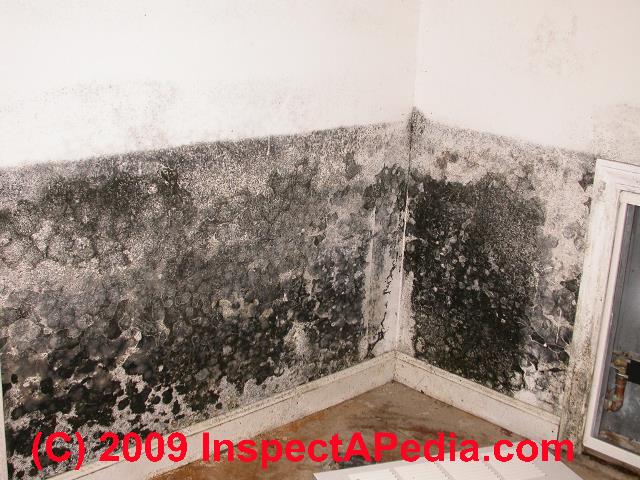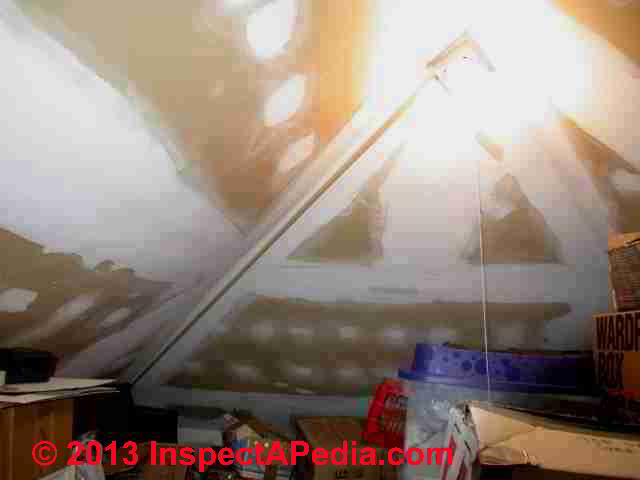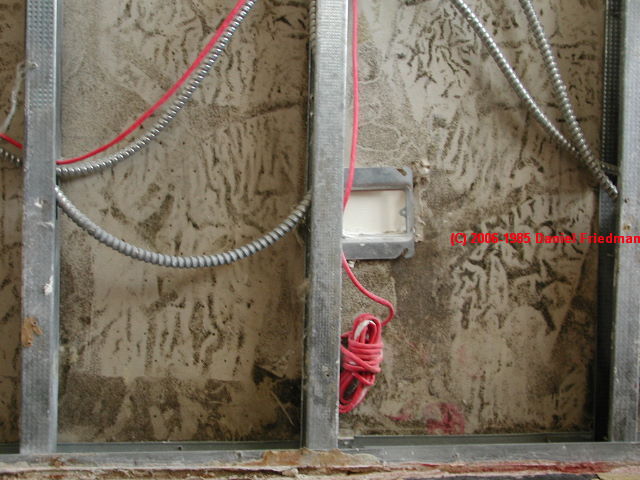 Mold proof drywall ? You Must Be Kidding!
Mold proof drywall ? You Must Be Kidding!
- POST a QUESTION or COMMENT about mold-resistant drywall and other mold-resistant building products & methods
Guide to mold-resistant drywall: evaluation & opinion:
Using mold-resistant drywall: this article reviews the benefits and limitations of using mold resistant drywall, gypsum board, or Sheetrock(TM) (which is a trademark) as a step in building mold-resistant construction.
We include a list of drywall standards and MSDS information. While mold-resistant drywall may be a good idea for some problem-prone building locations, avoiding mold growth in buildings requires more than just this product.
We also ask about the probable effectiveness of mold resistant drywall in large part because a careful reading of the manufacturer's data places very constrained limits on how this new and more expensive drywall is promised to perform.
InspectAPedia tolerates no conflicts of interest. We have no relationship with advertisers, products, or services discussed at this website.
- Daniel Friedman, Publisher/Editor/Author - See WHO ARE WE?
What are you getting if you buy the new "mold resistant" gypsum panels to use after your mold remediation project?
Both of the major drywall companies are now marketing drywall which is advertised as offering "mold and mildew resistance". I was excited to hear about this because drywall in buildings, when it has gotten wet or been subjected to prolonged high moisture, is a very common place for mold growth.
When a building has been wet or been subject to high indoor humidity, it is common to find problem-mold both on the visible or room-side and often on the hidden or wall-cavity side of drywall (illustrated later in this article).
Photo at left: severe mold contamination on the room-side of drywall in a wet basement. This was not a mold-resistant drywall product. But in this article we question how much better mold resistant drywall can perform under the same conditions that produced this mold problem.
[Click to enlarge any image]
First, Possibly Gouged:
at a central New York mold remediation project the contractor told me that his local supplier was charging him four to eight times the cost of "regular" drywall (which he calls "sheetrock" (a trademarked name) or "gyp board" which is slang for gypsum panels.
Second, Promised very little:
if the USG submittal sheet for "Sheetrock(R)" Brand Humitek(TM) Gypsum panels is any indicator, the manufacturer has given themselves an impressive escape clause. Quoting from the product limitations on this USG document, using its item numbers:
Photo at left: mold-free drywall in the attic of an older home. This product was also not a mold-resistant drywall material, but has performed perfectly well for several decades.
- Avoid exposure to temperatures exceeding 125 deg F (Translation: keep it away from your boiler flue, it's not fire-rated).
- Avoid exposure to excessive or continuous moisture before, during and after installation. Eliminate sources of moisture immediately.
(Translation: if you put this material in an environment where mold grew on your old drywall, we're not promising that this product will perform any better.
That advice is absolutely sound.
See MOLD RESISTANT CONSTRUCTION.) - Not suitable for use in high moisture areas such as tub and shower enclosures, gang showers, and other areas subject to direct water exposure.
(Translation: you shouldn't have used your old drywall in the bathroom and you shouldn't put this new product near the tub, sink, or shower.) - Non load bearing.
The moisture and mold resistance of this material is cited as "Per ASTM C473, the average water absorption for panels is not greater than 5 percent by weight after two-hour immersion."
Translation: sounds great, doesn't it? Indeed improving the resistance of drywall to moisture uptake should improve its mold resistance, as might painting it.
Really? In our OPINION, what all of this means is simple. In general we only find problem mold growth on drywall that has been subjected to excessive moisture, wetting, or actual building flooding. In other words, ordinary drywall products perform perfectly well in dry environments.
Since it would appear that the producers of mold resistant drywall warn that they cannot promise anything about its mold resistance in humid or wet environments, it is difficult to understand why the extra cost for mold resistant drywall would be justified.
And what remains un-defined is "excessive or continuous moisture before, during and after installation".
Just as our frustrating conversation with a hardboard siding manufacturer claims rep who told us "don't install it if it's too wet" but who would not give even the most vague hint what "too wet" means, we are left with a bit of uncertainty about the product and how it can perform.
In other words, if the building is dry you won't see problem mold growth on drywall. If the building is wet, nobody is promising you that the mold-resistant drywall will actually not become moldy.
See details at SIDING, FIBER CEMENT MOISTURE LEVELS
OPINION: Use mold resistant gypsum panels with hesitation and caution
This product sounds like a great idea but ... considering the limitations stated by the manufacturer, I would want to see a lot more about the make-up, testing, and field-use experience of this material before I'd pay the premium suppliers are getting to provide it to your mold remediation contractor.
Photo at left: severe mold contamination (Memnoniella echinata) in the wall cavity of a drywall covered New York city apartment wall that looked perfectly clean from the wall exterior.
See details at HIDDEN MOLD in CEILINGS / WALLS.
Anyone who has used moldproof drywall and sees what they think is mold growing on this new product is welcome to send a sample to my lab.
If your sample comes from Humitek™ or any other drywall manufacturer who provides mold-resistant drywall, we will process your sample pro-bono.
See DUST / MOLD TEST KIT INSTRUCTIONS for easy and inexpensive mold sampling procedures that work well for identifying mold or other particles found on drywall or on other surfaces.
...
Continue reading at HIDDEN MOLD in CEILINGS / WALLS or select a topic from the closely-related articles below, or see the complete ARTICLE INDEX.
Or see these
Recommended Articlers
- ASBESTOS in DRYWALL
- CHINESE DRYWALL HAZARDS
- DUST / MOLD TEST KIT INSTRUCTIONS
- DRYWALL MOLD TESTING
- DRYWALL MOLD RESISTANT
- HIDDEN MOLD in CEILINGS / WALLS
- MOLD PREVENTION GUIDE
- MOLD RESISTANT CONSTRUCTION
Suggested citation for this web page
DRYWALL MOLD RESISTANT at InspectApedia.com - online encyclopedia of building & environmental inspection, testing, diagnosis, repair, & problem prevention advice.
Or see this
INDEX to RELATED ARTICLES: ARTICLE INDEX to MOLD CONTAMINATION & REMEDIATION
Or use the SEARCH BOX found below to Ask a Question or Search InspectApedia
Or see
INDEX to RELATED ARTICLES: ARTICLE INDEX to BUILDING INTERIORS
Or use the SEARCH BOX found below to Ask a Question or Search InspectApedia
Ask a Question or Search InspectApedia
Questions & answers or comments about mold-resistant drywall and other mold-resistant building products & methods
.
Try the search box just below, or if you prefer, post a question or comment in the Comments box below and we will respond promptly.
Search the InspectApedia website
Note: appearance of your Comment below may be delayed: if your comment contains an image, photograph, web link, or text that looks to the software as if it might be a web link, your posting will appear after it has been approved by a moderator. Apologies for the delay.
Only one image can be added per comment but you can post as many comments, and therefore images, as you like.
You will not receive a notification when a response to your question has been posted.
Please bookmark this page to make it easy for you to check back for our response.
IF above you see "Comment Form is loading comments..." then COMMENT BOX - countable.ca / bawkbox.com IS NOT WORKING.
In any case you are welcome to send an email directly to us at InspectApedia.com at editor@inspectApedia.com
We'll reply to you directly. Please help us help you by noting, in your email, the URL of the InspectApedia page where you wanted to comment.
Citations & References
In addition to any citations in the article above, a full list is available on request.
- Association of the Wall & Ceiling Industry - Web: awci.org "AWCI represents 2,200 companies and organizations in the acoustics systems, ceiling systems, drywall systems, exterior insulation and finishing systems, fireproofing, flooring systems, insulation, and stucco contractors, suppliers and manufacturers and those in allied trades.
Our mission is to provide services and undertake activities that enhance the members' ability to operate a successful business." - Drywall Finishing Council "is a Not For Profit, Mutual Benefit Organization that seeks to represent the issues that are commonly faced by manufacturers of materials used in the finishing of drywall" - see dwfc.org and see this PDF about the Drywall Finishing Council.
The DFC website provides additional documents: "a visual evaluation method for inspecting joint treated gypsum panel surfaces", "Interior Job Condition Specifications For The Application Of Drywall Joint Compounds, Drywall Textures, And Paints/Coatings", and "guidelines for determining the visual performance expectations of a Level 5 finish" drywall systems. - Drywall Grid System Standards:
- ASTM C635 Standard Specification for the Manufacture, Performance, and Testing of Metal Suspension Systems for Acoustical Tile and Lay-in Panel Ceilings
- ASTM C636 Standard Practice for Installation of Metal Ceiling Suspension Systems for Acoustical Tile and Lay-in Panels
- ASTM C645 Standard Specification for Nonstructural Steel Framing Members
- ASTM C754 Standard Specification for Installation of Steel Framing Members to Receive Screw-Attached Gypsum Panel Products
- CISCA Ceiling & Interior Systems Construction Association
- DSA PA105 Division of the State Architect (California)
- IBC International Building Code
- ICC ESR-1289 International Code Council Evaluation Service
- NOA 04-0716.03 Dade/Broward County, Florida Product Approval
- RR25348 City of Los Angeles Research Report
- UBC 25-2 Uniform Building Code Standard (section 25.210, exception 2)
- UL Underwriters Laboratories Inc. Fire Resistance Directory
- Also see the Armstrong Corporation's article on drywall grid system installation details at armstrong.com/common/c2002/content/files/4279.pdf or contact the company at 877-ARM-STRONG
- Gypsum Association, www.gypsum.org - 810 First St. N.E. Suite 510, Washington D.C. 20002, 202-289-4550. A gypsum drywall trade association that includes the following corporations: American Gypsum logo,
CertainTeed Gypsum, Inc.,
CertainTeed Gypsum Canada Inc.,
CGC Inc.,
Federal Gypsum Company, Georgia-Pacific Gypsum,
Lafarge North America, National Gypsum Co.,
PABCO Gypsum,
Temple-Inland,
United States Gypsum. (Most of these companies also publish product installation and specifications guides.)
The Gypsum Association association provides quite a few online documents addressing the installation and assessment of gypsum board products, including- Gypsum Board Evaluation Report - ES Report ESR-1338, 12/1/2007, Division 09, Gypsum Board Assemblies, prepared by ICC Evaluation Service, Inc. (icc-es.org) provides an independent evaluation of contemporary drywall or gypsum board products with respect to building code compliance (2006 International Building Code IBC and the 2006 International Residential Code IRC) with respect to interior finish, fire resistance, sound control, structural considerations, thermal barrier, and exterior finish.
- Assessing Water Damage to Gypsum Board - (GA-231-06), "general industry conditions for assessing gypsum board that has been exposed to water or elevated levels of moisture. Includes recommendations for drying conditions" - available for purchase in hard copy form at www.gypsum.org
- "Recommended Levels of Gypsum Board Finish", available at www.gypsum.org
- Fire Resistance Design Manual GA-600, The 18th edition includes fire-resistance ratings for over 370 gypsum-protected wall, ceiling, roof, column, beam, girder, and truss systems. available for purchase in hard copy form at www.gypsum.org
- Recommended Levels of Gypsum Board Finish (GA-214-07), "jointly produced by the four leading associations in the industry, assists specifiers, owners, and contractors to precisely describe the desired finish of individual walls and ceilings to meet specific needs. Avoids non-specific terms like "industry standards" and "workmanlike finish" and the problems they can cause" available for purchase in hard copy form at www.gypsum.org
- Repairing Screw or Nail Pops [in drywall or gypsum board] (GA-222-08), "the symptoms, causes, and repair methods for fastener pops in gypsum board surfaces." available for purchase in hard copy form at www.gypsum.org
- Massachusetts Design & Construction Guidelines & Standards for Gypsum Drywall - 09 20 00
- MSDS Material Safety Data Sheets for various drywall products
- FIBEROCK® Brand Gypsum Fiber Underlayment - (US Gypsum) MSDS
- FIBEROCK® Brand Abuse-Resistant Gypsum Fiber Panels (US Gypsum) MSDS
- FIBEROCK® Brand Gypsum Fiber Sheathing Panels (US Gypsum) MSDS
- Fiberock® Brand Aqua-Tough™Interior Panels (US Gypsum) MSDS
- Hamilton drywall products Sher-Tex® PremiumMSDS
- Plaster - sample (US Gypsum) MSDS
- SHEETROCK® Brand Gypsum Panels (US Gypsum) MSDS
- SHEETROCK® Brand HUMITEK™ Gypsum Liner Panels (US Gypsum) MSDS
- Additional pertinent product MSDS from US Gypsum are at www.cgcinc.com/home.asp?nav=38&mkt=30&bc=1.18.38
- Thanks to Jamie S. for detailed link editing assistance 4/11/2009
- Our recommended books about building & mechanical systems design, inspection, problem diagnosis, and repair, and about indoor environment and IAQ testing, diagnosis, and cleanup are at the InspectAPedia Bookstore. Also see our Book Reviews - InspectAPedia.
- American Plywood Association, APA, "Portland Manufacturing Company, No. 1, a series of monographs on the history of plywood manufacturing",Plywood Pioneers Association, 31 March, 1967, www.apawood.org
- ASHRAE resource on dew point and wall condensation - see the ASHRAE Fundamentals Handbook, available in many libraries.
- 2005 ASHRAE Handbook : Fundamentals: Inch-Pound Edition (2005 ASHRAE HANDBOOK : Fundamentals : I-P Edition) (Hardcover), Thomas H. Kuehn (Contributor), R. J. Couvillion (Contributor), John W. Coleman (Contributor), Narasipur Suryanarayana (Contributor), Zahid Ayub (Contributor), Robert Parsons (Author), ISBN-10: 1931862702 or ISBN-13: 978-1931862707
- 2004 ASHRAE Handbook : Heating, Ventilating, and Air-Conditioning: Systems and Equipment : Inch-Pound Edition (2004 ASHRAE Handbook : HVAC Systems and Equipment : I-P Edition) (Hardcover)
by American Society of Heating, ISBN-10: 1931862478 or ISBN-13: 978-1931862479
- 1996 Ashrae Handbook Heating, Ventilating, and Air-Conditioning Systems and Equipment: Inch-Pound Edition (Hardcover), ISBN-10: 1883413346 or ISBN-13: 978-1883413347 ,
- Principles of Heating, Ventilating, And Air Conditioning: A textbook with Design Data Based on 2005 AShrae Handbook - Fundamentals (Hardcover), Harry J., Jr. Sauer (Author), Ronald H. Howell, ISBN-10: 1931862923 or ISBN-13: 978-1931862929
- 1993 ASHRAE Handbook Fundamentals (Hardcover), ISBN-10: 0910110964 or ISBN-13: 978-091011096
- Best Practices Guide to Residential Construction, by Steven Bliss. John Wiley & Sons, 2006. ISBN-10: 0471648361, ISBN-13: 978-0471648369, Hardcover: 320 pages, available from Amazon.com and also Wiley.com. See our book review of this publication.
- "Insulation: Adding Insulation to an Existing Home," U.S. Department of Energy - tips on how to do your own check for the presence of absence of insulation in a home
- The National Institute of Standards and Technology, NIST (nee National Bureau of Standards NBS) is a US government agency - see www.nist.gov
- "A Parametric Study of Wall Moisture Contents Using a Revised Variable Indoor Relative Humidity Version of the "Moist" Transient Heat and Moisture Transfer Model [copy on file as/interiors/MOIST_Model_NIST_b95074.pdf ] - ", George Tsongas, Doug Burch, Carolyn Roos, Malcom Cunningham; this paper describes software and the prediction of wall moisture contents. - PDF Document from NIS
- In addition to citations & references found in this article, see the research citations given at the end of the related articles found at our suggested
CONTINUE READING or RECOMMENDED ARTICLES.
- Carson, Dunlop & Associates Ltd., 120 Carlton Street Suite 407, Toronto ON M5A 4K2. Tel: (416) 964-9415 1-800-268-7070 Email: info@carsondunlop.com. Alan Carson is a past president of ASHI, the American Society of Home Inspectors.
Thanks to Alan Carson and Bob Dunlop, for permission for InspectAPedia to use text excerpts from The HOME REFERENCE BOOK - the Encyclopedia of Homes and to use illustrations from The ILLUSTRATED HOME .
Carson Dunlop Associates provides extensive home inspection education and report writing material. In gratitude we provide links to tsome Carson Dunlop Associates products and services.




